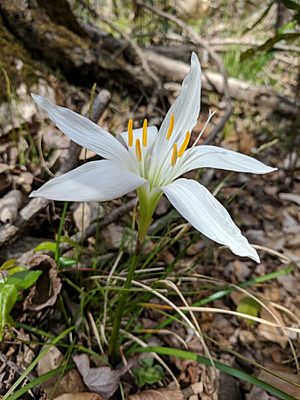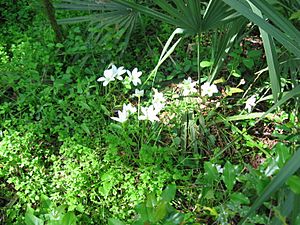Atamasco lily facts for kids
Quick facts for kids Atamasco lily |
|
|---|---|
 |
|
| Scientific classification | |
| Synonyms | |
|
See article |
The Atamasco lily (scientific name: Zephyranthes atamasca) is a beautiful flower. People also call it a rain-lily. It grows naturally in the southeastern United States.
You can find these lilies in wet places. They like swampy forests and coastal prairies. They prefer soil that is a bit acidic and rich in decaying leaves.
Their long, grassy leaves appear in early winter. The pretty white flowers bloom in March or April. Each leaf is about 0.5 inches (13 mm) wide. They can be 10 to 15 inches (25 to 38 cm) long.
The Atamasco lily grows from Florida up to Maryland. It also grows west to Mississippi. This plant has also started growing in Bermuda and the Mariana Islands. Be careful, as both its leaves and bulbs are poisonous.
What's in a Name?
Plants have scientific names, just like people have first and last names. The scientific name for this lily is Zephyranthes atamasca.
In 1753, a famous scientist named Carl Linnaeus first named this plant. He put it in a group called Amaryllis. He used the name "Atamasca" for it. This name comes from a Native American word.
Later, another scientist, William Herbert, moved the lily to a new group. This new group was called Zephyranthes. He used a slightly different spelling, "Atamasco".
Today, the official spelling for the scientific name is Zephyranthes atamasca. This is because of special rules for naming plants. These rules help scientists around the world understand which plant they are talking about.
See also
 In Spanish: Zephyranthes atamasco para niños
In Spanish: Zephyranthes atamasco para niños



